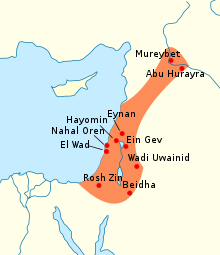納圖夫文化

納圖夫文化(英語:Natufian culture,發音/nəˈtuːfiən/[1])是西亞黎凡特地區後舊石器時代(Epipalaeolithic)的一種考古學文化,距今約 1.5萬至 1.15萬年前。[2] 該文化一個顯著特點是,它在農業引入前就支撐一種定居或半定居的人口。
納圖夫人可能是其所在地區最初的新石器時代定居點的建造者的祖先,而這些定居點可能是世界上最早的。
在史前文化考古遺址阿布·赫雷拉(Tell Abu Hureyra),位於今敘利亞上幼發拉底河谷,發現了納圖夫人有意種植穀物,尤其是黑麥的證據。這是世界上最早的農業證據之一。[3]
在約14,400年前的約旦東北部沙漠的舒巴伊卡1號(Shubayqa 1)遺址,發現了世界上最古老的類麵包食物生產證據,這一發現比西南亞的農業出現早了4000年。[4]
在以色列海法附近的迦密山拉凱費特洞穴(Raqefet Cave),發現了約13,000年前的古老啤酒製造證據。儘管與啤酒相關的殘留物可能是自發發酵的結果,但這一發現仍被認為是釀造啤酒的最早證據之一。[5][6]
考古遺傳學研究表明,後期(新石器時代到青銅器時代)黎凡特人的起源主要來自納圖夫人,同時也受到來自安納托利亞銅石並用時代人群的顯著混合影響。[8]
發現
[編輯]納圖夫文化是由英國考古學家多蘿西·加羅德(Dorothy Garrod)在約旦河西岸的猶太山脈舒克巴洞穴(Shuqba cave)發現的。
在1930年代之前,英國巴勒斯坦地區的考古工作主要集中於與歷史相關的聖經考古學,鮮有對史前時期的研究。
1928年,加羅德受邀到耶路撒冷的英國考古學校(Kenyon Institute)挖掘舒克巴洞穴,四年前馬隆神父(Alexis Mallon)在此發現了史前石器。她在該洞穴發現了一層夾在舊石器時代晚期與青銅時代之間的沉積物,以微石器為特徵。她將這一層認定為中石器時代,這一時期在歐洲有較多代表性,但在近東尚未發現。一年後,加羅德在el-Wad露台發現了類似材料,並將其命名為「納圖夫文化」,以此紀念靠近舒克巴的納圖夫谷(Wadi an-Natuf)。
在接下來的二十年中,加羅德在卡梅爾山地區的多處挖掘中發現了納圖夫文化的遺物,包括el-Wad、Kebara和Tabun,法國考古學家雷內·紐維爾(René Neuville)也有相關發現,進一步確立了納圖夫文化在該地區史前年表中的地位。
早在1931年,加羅德和紐維爾就注意到納圖夫遺物中石制鐮刀的存在,提出這可能代表了非常早期的農業。
年代
[編輯]納圖夫文化出現在Bølling–Allerød間冰期,隨後在新仙女木期經歷了一次明顯的溫度下降。新仙女木期結束時,氣溫再次上升,標誌著全新世和新石器革命的到來。冰期後氣候變化的情況可以通過格林蘭冰芯的分析了解。
放射性碳定年顯示,納圖夫文化的時期大致為公元前12,500年至9,500年,屬於更新世末期至全新世初期。
這一時期通常分為兩個子時期:早期納圖夫文化(公元前12,000年至10,800年)和晚期納圖夫文化(公元前10,800年至9,500年)。
晚期納圖夫文化可能與新仙女木期(公元前10,800年至9,500年)重疊。黎凡特地區在這一時期擁有超過一百種可食用植物,包括穀物、水果和堅果,而當時的黎凡特並非如今的乾旱、貧瘠之地,而是覆蓋著森林的區域。
相關文化
[編輯]納圖夫文化起源於早期的克巴拉文化(Kebaran culture,距今約2.3萬年前至約1.5萬年前),被視為其繼承者。該地區還存在其他文化,如內蓋夫和西奈半島的穆沙比文化(Mushabian culture,距今約1.4萬年至約1.25萬年前),這些文化可能與克巴拉文化不同,或參與了納圖夫文化的演變。
參考資料
[編輯]- ^ Natufian. 牛津英語詞典 (第三版). 牛津大學出版社. 2005-09 (英語).
- ^ Grosman, Leore. The Natufian Chronological Scheme – New Insights and their Implications. Bar-Yosef, Ofer; Valla, François R. (編). Natufian Foragers in the Levant: Terminal Pleistocene Social Changes in Western Asia 1. New York: Berghahn Books. 2013: 622–627 [2021-11-14]. ISBN 978-1-879621-45-9. JSTOR j.ctv8bt33h. (原始內容存檔於2022-01-30) –透過JSTOR.
- ^ Moore, Andrew M. T.; Hillman, Gordon C.; Legge, Anthony J., Village on the Euphrates: From Foraging to Farming at Abu Hureyra, Oxford: Oxford University Press, 2000, ISBN 978-0-19-510806-4
- ^ Prehistoric bake-off: Scientists discover oldest evidence of bread. BBC. 17 July 2018 [17 July 2018]. (原始內容存檔於2020-05-19).
- ^ 'World's oldest brewery' found in cave in Israel, say researchers. British Broadcasting Corporation. 15 September 2018 [15 September 2018]. (原始內容存檔於2018-09-15).
- ^ '13,000-year-old brewery discovered in Israel, the oldest in the world. The Times of Israel. 12 September 2018 [16 September 2018]. (原始內容存檔於2020-02-16).
- ^ Kottak, Conrad P., Window on Humanity: A Concise Introduction to Anthropology, Boston: McGraw-Hill: 155–156, 2005, ISBN 978-0-07-289028-0
- ^ Lazaridis, Iosif; Nadel, Dani; Rollefson, Gary; Merrett, Deborah C.; Rohland, Nadin; Mallick, Swapan; Fernandes, Daniel; Novak, Mario; Gamarra, Beatriz; Sirak, Kendra; Connell, Sarah; Stewardson, Kristin; Harney, Eadaoin; Fu, Qiaomei; Gonzalez-Fortes, Gloria; Jones, Eppie R.; Roodenberg, Songül Alpaslan; Lengyel, György; Bocquentin, Fanny; Gasparian, Boris; Monge, Janet M.; Gregg, Michael; Eshed, Vered; Mizrahi, Ahuva-Sivan; Meiklejohn, Christopher; Gerritsen, Fokke; Bejenaru, Luminita; Blüher, Matthias; Campbell, Archie; Cavalleri, Gianpiero; Comas, David; Froguel, Philippe; Gilbert, Edmund; Kerr, Shona M.; Kovacs, Peter; Krause, Johannes; McGettigan, Darren; Merrigan, Michael; Merriwether, D. Andrew; O'Reilly, Seamus; Richards, Martin B.; Semino, Ornella; Shamoon-Pour, Michel; Stefanescu, Gheorghe; Stumvoll, Michael; Tönjes, Anke; Torroni, Antonio; Wilson, James F.; Yengo, Loic; Hovhannisyan, Nelli A.; Patterson, Nick; Pinhasi, Ron; Reich, David. Genomic insights into the origin of farming in the ancient Near East (PDF). Nature. 2016, 536 (7617): 419–424 [2021-11-14]. Bibcode:2016Natur.536..419L. PMC 5003663
 . PMID 27459054. doi:10.1038/nature19310. (原始內容存檔 (PDF)於2021-02-12). Fig. 4. "Our data document continuity across the transition between hunter– gatherers and farmers, separately in the southern Levant and in the southern Caucasus–Iran highlands. The qualitative evidence for this is that PCA, ADMIXTURE, and outgroup f3 analysis cluster Levantine hunter–gatherers (Natufians) with Levantine farmers, and Iranian and CHG with Iranian farmers (Fig. 1b and Extended Data Figs 1, 3). We confirm this in the Levant by showing that its early farmers share significantly more alleles with Natufians than with the early farmers of Iran" Epipaleolithic Natufians were substantially derived from the Basal Eurasian lineage. "We used qpAdm (ref. 7) to estimate Basal Eurasian ancestry in each Test population. We obtained the highest estimates in the earliest populations from both Iran (66±13% in the likely Mesolithic sample, 48±6% in Neolithic samples), and the Levant (44±8% in Epipalaeolithic Natufians) (Fig. 2), showing that Basal Eurasian ancestry was widespread across the ancient Near East. [...] The idea of Natufians as a vector for the movement of Basal Eurasian ancestry into the Near East is also not supported by our data, as the Basal Eurasian ancestry in the Natufians (44±8%) is consistent with stemming from the same population as that in the Neolithic and Mesolithic populations of Iran, and is not greater than in those populations (Supplementary Information, section 4). Further insight into the origins and legacy of the Natufians could come from comparison to Natufians from additional sites, and to ancient DNA from North Africa."
. PMID 27459054. doi:10.1038/nature19310. (原始內容存檔 (PDF)於2021-02-12). Fig. 4. "Our data document continuity across the transition between hunter– gatherers and farmers, separately in the southern Levant and in the southern Caucasus–Iran highlands. The qualitative evidence for this is that PCA, ADMIXTURE, and outgroup f3 analysis cluster Levantine hunter–gatherers (Natufians) with Levantine farmers, and Iranian and CHG with Iranian farmers (Fig. 1b and Extended Data Figs 1, 3). We confirm this in the Levant by showing that its early farmers share significantly more alleles with Natufians than with the early farmers of Iran" Epipaleolithic Natufians were substantially derived from the Basal Eurasian lineage. "We used qpAdm (ref. 7) to estimate Basal Eurasian ancestry in each Test population. We obtained the highest estimates in the earliest populations from both Iran (66±13% in the likely Mesolithic sample, 48±6% in Neolithic samples), and the Levant (44±8% in Epipalaeolithic Natufians) (Fig. 2), showing that Basal Eurasian ancestry was widespread across the ancient Near East. [...] The idea of Natufians as a vector for the movement of Basal Eurasian ancestry into the Near East is also not supported by our data, as the Basal Eurasian ancestry in the Natufians (44±8%) is consistent with stemming from the same population as that in the Neolithic and Mesolithic populations of Iran, and is not greater than in those populations (Supplementary Information, section 4). Further insight into the origins and legacy of the Natufians could come from comparison to Natufians from additional sites, and to ancient DNA from North Africa."
